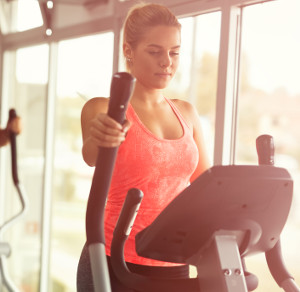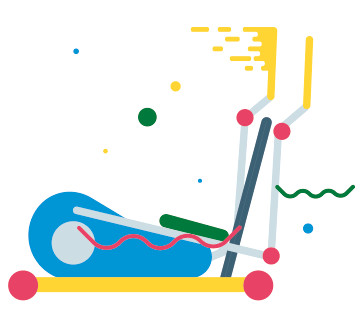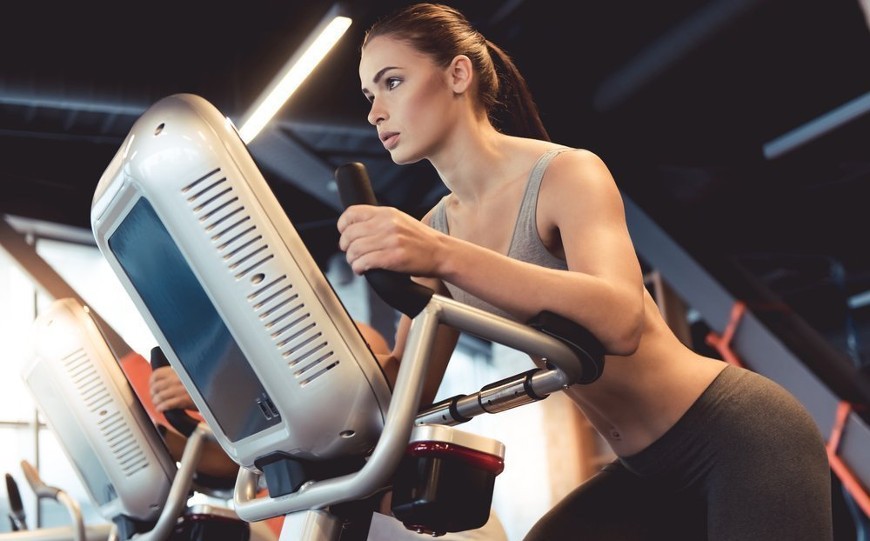How to Use a Cross Trainer to Lose Weight?
Do you want to lose weight, have a beautiful silhouette, firm thighs and muscular buttocks? Want to know how to exercise on your elliptical cross trainer to burn a maximum of calories? To know how long it can take? And to know if the elliptical machine does not risk to inflate your legs and thighs? We are going to explain you everything you need to know and give you plenty of tips and tricks to effectively lose weight by cycling on an elliptical cross trainer and enter into a virtuous circle!
1. How many calories can you burn using an elliptical trainer?
| Activity | Calories burned for 30 minutes of exercise | Calories burned for 1 hour of exercise |
|---|---|---|
| Walking (5km/h) | 100 kcal | 207 kcal |
| Elliptical Cross Trainer, low intensity | 225 kcal | 450 kcal |
| Elliptical Cross Trainer, medium intensity | 325 kcal | 650 kcal |
| Elliptical Cross Trainer, very high intensity | 415 kcal | 830 kcal |
30 minutes of cross trainer at a medium intensity allow you to burn 325 kcal, which is equivalent to a chocolate muffin or 8 carrots!
1h of exercise on your elliptical machine at a high intensity allows you to burn 830 kcal, the equivalent of a beautiful roast chicken thigh with potatoes or about 20 carrots!
These comparisons are fun but do not tell us about the basics! How many calories should you burn to lose 1 kilo?
How many calories do you need to burn to lose 1kg? 1g of fat is equivalent to 9 kilocalories. It is therefore necessary to burn 9 000 kilocalories to lose 1 kg of fat, or 1,000g. The body, however, burns calories at rest, especially for digestion, at a rate of 2,000 kcal per kilo of fat. You need to burn 7,000 kilocalories to lose 1 kg of fat, your body will burn the remaining 2,000 kcal anyway, even if you don't ask for it.
Calories or Kilocalories ? We often hear people confuse calories and kilocalories. A banana contains 130 kcal and not 130 calories. In nutrition, the unit Cal is used with a capital letter and then means 1kcal or 1,000 cal (a Cal is sometimes called a great calorie), which makes things even more complicated... In clear, 1,000 cal = 1 kcal = 1 Cal.
What are exactly calories? Calories are a unit of measurement of the energy value of food, that is the amount of energy our body can produce from food. Our body needs energy to function and this energy is brought by the food we eat. When we exercise, our body needs more energy and therefore burns more calories than at rest.
-
2. How long should you exercise on your elliptical trainer to lose weight?
To lose 1kg, you need to burn 7,000 kilocalories more, that means almost 10 hours of intensive workout on your elliptical bike. If we do the calculation, you should work out 1 hour on your elliptical bike 2 times a week during 1 month! Or do 20 minutes of cross trainer every day at high intensity, which allows you to burn exactly 8,300 kcal in a month and thus lose 1 kilo.
However, it is not so easy to stay at a very high intensity for an hour. Therefore, if you practice the elliptical trainer without exerting too much pressure by training 3 times a week at medium intensity for 1 hour in each session, you will lose 1kg after a month.
You are probably wondering if it is not better to focus on intensive training, called high intensity interval training or HIIT, more effective in losing calories quickly and therefore losing weight faster. But is this really the case?
To lose 1 kg per month. Working out 1h on your elliptical machine 3 times a week will help you lose 1 kg per month. Another way to lose 1 kilo in a month is to exercise 20 minutes each day at a very high intensity (doing HIIT).
3. What workout to lose weight: cardio or HIIT?
The high intensity interval training (HIIT) is a short-term, intensive training program that enables you to burn a lot of calories in a very short time. It is however very short precisely because it is very intense and thus usually much shorter than a cardio workout. For instance, if you cycle at a very high intensity for 30 minutes, you will burn 415 kcal while you will burn 650 kcal if you exercise at medium intensity for 1 hour.
Also, during an interval training, your heart rate increases and reaches the anaerobic zone, that is, 80-90% of your maximum heart rate (FCM). In the anaerobic zone, your body needs energy quickly and will use your sugar reserves while during a prolonged cardio workout in the aerobic zone, at 60-80% of your maximum heart rate, your body will tap into the fat stores to produce energy
Hence this existential dilemma: Should I rather do a long cardio workout or a short HIIT workout routine to lose weight? Which one is more effective?
Researchers at the Florida State University attempted to answer this question. They took 2 groups of people: the first group followed an interval training and the second group a classical cardio training, all the people burning the same number of calories during the workout. They found found out that the people who had been engaged in a HIIT workout had burned 10% more calories during the 24 hours after training than those who did the classical cardio workout. It means that we keep burning calories and fat for several hours after the training session!
-
In a study 1 published in the Journal of Medicine and Science in Sports and Exercise, the participants who had to cycle vigorously on a bike for 45 minutes burned 190 kilocalories after the exercise in the following 14 hours, which is 37% of the calories they burned during exercise. This is called the afterbun effect, or in scientific terms the excess post-exercise oxygen consumption (EPOC) 2: it means that our body continues to burn calories and fat many hours after exercise.
According to the most recent studies, the best would be to alternate between cardio and HIIT workouts! Do for example 1 to 2 HIIT sessions per week and 1 to 2 sessions of cardio training. This mix would have superior benefits on the body and would be more efficient for losing weight! In addition, it is essential for the motivation to vary and not always do the exact same workout (see below our training plan).
What you should know. After an interval training (HIIT), our body continues to burn calories for 24 hours!
Here are two workout plans for elliptical bike to lose weight: N°1 (Goal: 0,5kg / month) and N°2 (Goal: 1kg / month) :
Workout Plan N°1
• Cardio Workout on Tuesday (30 min)
• HIIT Workout on Thursday (20 min)
• Cardio Workout on Sunday (45 min)
Workout Plan N°2
• Cardio Workout on Monday (30 to 45 min)
• HIIT Workout on Tuesday and Thursday (25 min)
• Cardio Workout on Saturday (45 to 60 min)
Find our cardio and HIIT workouts for elliptical cross trainer with the description of each training program, difficulty, duration and number of calories burned.
4. The elliptical trainer to gain muscles and have a beautiful body!
Calories are not everything! The elliptical cross trainer allows you to lose calories and pounds but it also helps you to tone your muscles! Muscles and especially the ratio of fats / muscles determine your silhouette and the appearance of your body.
Why is it important to gain muscle when you want to lose weight?
The first reason is simple: the muscles define your body and its appearance. You will have beautiful buttocks only if you exercise regularly. Similarly, it is important to lose pounds but if you want thinner and firm thighs, it is absolutely necessary to combine weight loss and workout on your elliptical to strengthen your thighs. Rest assured, your legs and your thighs won't double in volume if you exercise on your elliptical trainer. The elliptical machine is a cardio machine and not a strength machine. It will tone your muscles but not transform you into a body builder! It's the ideal fitness machine for all those who wish to have a beautiful body with beautiful legs and beautiful buttocks.
The second reason is the following: gaining muscles allows you to enter a virtuous circle. Muscles burn 3 times more calories at rest than fat! More muscles mean more calories burned without doing anything. This is all the more important since after the age of 25, you keep losing muscles and gaining fat, and this increases with age. It is therefore vital to compensate by regularly exercising and gaining muscles.
The elliptical cross trainer brings you into a virtuous circle: you will lose fat, increase your muscle mass and this extra muscle mass will help you burn more calories at rest!
What you should know. It is not possible to choose in which parts of the body you will lose weight, for example exclusively from the thighs or the belly! The contrary would be great but this is unfortunately not the case. When you lose fat and pounds, they decrease a little everywhere. However, you can target your thighs during exercise to strengthen and tone them more.
What muscles does the elliptical work?
The elliptical trainer targets legs, thighs and buttocks but also works your arms (biceps and triceps), especially when you pull or push the bars actively. In addition, the muscles of your abdomen and your back also work, to a lesser extent though. It is possible to target specific muscles on the elliptical machine. For example, when you push the pedals actively with the front of your feet, your thighs work harder while your glutes are targeted when you step back a little and lower slightly while holding the bars without moving the arms.
The more you increase the resistance of your elliptical cross trainer, the more your muscles work. Some workout programs target specific muscles of your body.
2 misconceptions about muscles and fats! The muscles would be 5 to 10 times heavier than fat and muscles would make you fat: it's NOT TRUE! Muscles weigh only 15% more than fat. There is really no reason to worry! On top of that, muscles burn more calories at rest than fat. Here comes the second misconception. Muscles would burn 50 times more calories than fats: alas, it's WRONG! Muscles actually consume 3 times more calories than fat.
How to calculate your muscle mass and your fat mass?
To know your muscle and fat mass, you need a body fat scale (like this one or that one from the brand Nokia). The body fat scale tells you the exact percentage of fat and muscle of your body. The relation between muscles and fats is important since this it what determines your body and its appearance. The higher your muscle mass relative to your total weight, the more muscular and athletic your body looks.
Once you know your muscle mass in kg (if it's in %, multiply it by your weight), multiply that number by 12 and you will get the number of calories your muscles burn at rest each day. You will be able to follow the evolution of your muscle mass and your fat mass over time and see how many calories your muscles burn at rest. The goal is not to have as many muscles as possible but to find the right balance that is good for you.
The body fat percentage (BFP)
| Women | |
|---|---|
| IMG < 25% | Too thin |
| 25% < IMG < 30% | Average |
| IMG > 30% | Fat percentage is too high |
| Men | |
|---|---|
| IMG < 15% | Too thin |
| 15% < IMG < 20% | Average |
| IMG > 20% | Fat percentage is too high |
The important thing is to lose fat and not muscles, that's why you always have to do sports and exercise when you want to lose weight! With the elliptical machine, you can increase your muscle mass in a reasonable way and reduce your body fat percentage. It is the ideal fitness machine if your goal is to refine your body, tone your legs and your thighs, strengthen your buttocks but also to gain muscle in your arms. It offers a very complete workout for the whole body.
Sports and regular exercise are not enough to lose weight! It is necessary to find a balance between ingested calories and calories spent, which requires a varied and healthy diet!
What you should know. Men have by nature more muscles than women: the average muscle mass of men is 35% and 28% for women. This explains why it is harder for women to lose weight because men lose pounds faster for an equivalent diet.
-
5. How to lose weight: the right balance between calories intake and calories burned?
What are our daily caloric needs?
| Age | Daily caloric needs for men | Daily caloric needs for women |
|---|---|---|
| 25 to 51 years | 2 700 kcal | 2 200 kcal |
| 51 to 65 years | 2 500 kcal | 2 000 kcal |
| 65 years and over | 2 300 kcal | 1 800 kcal |
The calorie requirements described in this table are those of people having a light physical activity in the day of about 30 minutes. These values vary according to the physical activity (duration and intensity): approximately + 10% per hour of physical activity and up to -10% in the absence of any physical activity.
A 35-year-old woman who consumes 2,200 kilocalories a day will be in balance. If her diet makes her overtake her caloric needs and if she takes 3,000 kcal per day for example, then she will gain weight. On the other hand, if for example, without changing her diet, she exercises 1 hour on the elliptical bike 2 to 3 times a week, then she will lose weight in ideal conditions and develop her muscle mass.
Good and bad news! We, humans, store fat very well but are reluctant to get rid of fat! To some of you, this rather sounds like two bad news... Our body only burns fat if it is forced to do it, this happens especially during a physical activity or exercise!
7 tips and advice to change your diet and lose weight
1. Do not step into a diet if you know in advance that you won't be able to make it for the rest of your life because if it is the case, there will always come a time when you will stop it and regain all the pounds you had lost. That's useless! The key to success is in the long run: you have to change your habits and your diet once for all and not start again a new diet which is even more more bizarre than the previous one.
2. Do not eat outside of the meal times and try to eat at fixed times (and eat your dinner not too late to be able to digest before going to bed).
3. Replace sodas and sweetened drinks simply with water! Sugar sweetened beverages have tons of calories: 1l of coke contains more than 400 kcal and 100g of sugar, which is equivalent to more than 33 pieces of sugar. Also try not to put sugar in your coffee or your tea (you will see, you will get used to it very quickly).
4. Replace the chocolate bars with fruits. A snickers contains 250 kcal and 30g of sugars (7 teaspoons of sugar) while an apple contains on average only 75 kcal and 15g of natural sugar (carbohydrates). Generally, eat fruit when you are hungry outside meals. Fruit has the added benefit of being digested more slowly and filling you longer, which gives you less desire to nibble.
5. Eat fruits and vegetables every day. Official recommendations say 2 fruits per day and 3 servings of vegetables. It's not easy, but you can increase your consumption little by little over time. Set the goal for one fruit and one portion of vegetables per day at the beginning!
6. Do not eat too much pasta or white bread because they contain starch that is converted into sugar by our body. For example, replace white bread with wholemeal bread, more nourishing, and pasta with zucchini.
7. Cook! Be creative and enjoy cooking by looking for recipes on the Internet or on Pinterest. If you do not cook, start by cooking 1 time a week after looking for a recipe. Vary the pleasures and over time you will develop new habits towards a healthy and balanced diet.
The cross trainer is the ideal sports to lose weight and at the same time tone your legs, thighs and glutes. It offers a complete workout of the arms, legs and stomach while allowing to target specific areas of your body through appropriate training programs! For weight loss, combine regular physical training with a balanced diet to find the right balance between the number of calories ingested and the number of calories burned. Follow all these tips to effectively lose weight and enter into a virtuous circle!
Here are a few more tips that will help you stay motivated and lose weight with your elliptical machine. If you follow these tips, there is no doubt, you will get rid of those extra pounds!
OUR TIPS TO LOSE WEIGHT USING AN ELLIPTICAL CROSS TRAINER
- Set a reachable goal! Do not try to do too much like cycling on your elliptical bike every day for 1h because you may loose motivation quickly and then it comes to the yoyo effect, you will immediately regain the pounds you had lost. Try to set a target of 7,000 kilocalories to burn each month to lose 1kg by training on your cross trainer or 3,500 kcal to lose 0.5kg by doing 30 to 45 minutes of elliptical bike twice a week, which is already very good. You can always increase your training sessions over time if you feel you can do more but do not do the opposite...
- Develop a habit: practice every Wednesday and Sunday evening at 6:30 pm for 1 hour and never miss your training session! With the Vescape application, you can create workouts by calling them "Wednesday 6:30 pm", "Sunday 6:30 pm", which will help you to stick to your training plan!
- Follow the evolution of your muscle and body fat percentage with a body fat scale.
- Combine the workout with a balanced diet! Do not eat too much fat, not too sweet, not outside meals and do not exceed your daily calorie needs. This is how you will succeed in losing weight. The key to success is consistency and perseverance!
References:
1. A 45-minute vigorous exercise bout increases metabolic rate for 14 hours. Knab AM1, Shanely RA, Corbin KD, Jin F, Sha W, Nieman DC. Medicine and Science in Sports and Exercise, 2011 Sep. 43(9):1643-8. doi: 10.1249/MSS.0b013e3182118891.
2. Effects of exercise intensity and duration on the excess post-exercise oxygen consumption. LaForgia J1, Withers RT, Gore CJ. Journal of Sports Sciences, 2006 Dec. 24(12):1247-64.

Clara Miller has a Master's degree in Sports Science and Sports Management and has worked for famous sports and fitness brands. She is passionate about sports and regularly writes about fitness, weight loss and motivation for various blogs and magazines.
RELATED ARTICLES:

5 Cross Trainer Workout Routines for Beginners and Advanced
Discover our cardio and HIIT training programs for elliptical trainer for beginners and confirmed to be downloaded for free! Read the article

10 Tips to Choose the right Elliptical Machine
What are the important criteria to consider when choosing an elliptical trainer? Follow our tips and find the right cross trainer that suits you best! Read the article
OUR ELLIPTICAL CROSS TRAINERS SELECTION
{products:11,12,13,10}





